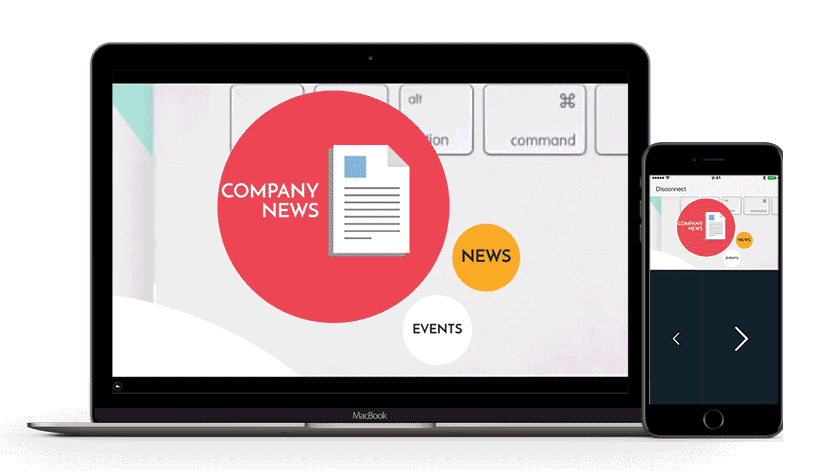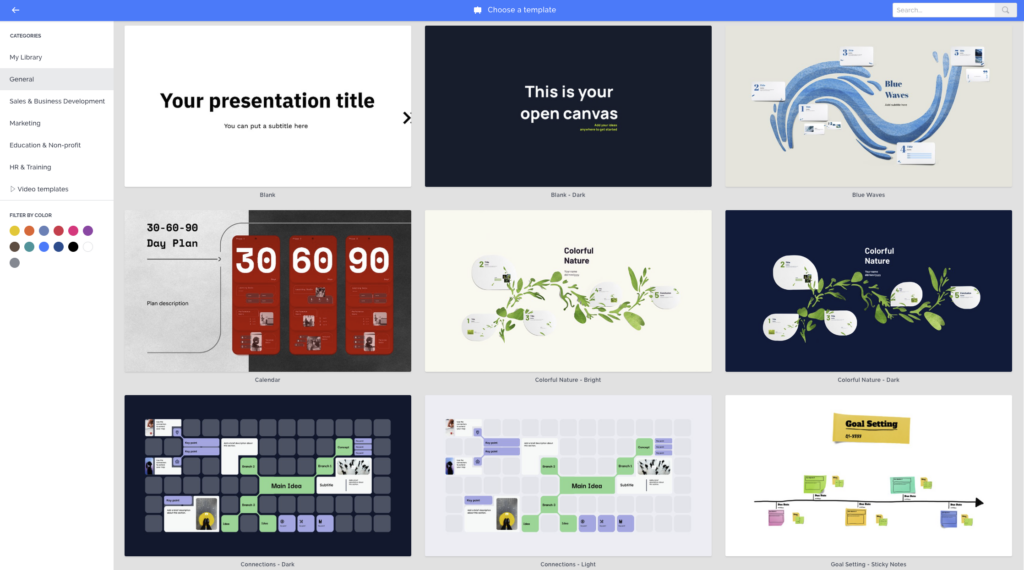Let’s say you have a big idea – a new invention, a product launch, or a smarter way of doing things. To get your idea heard you need a way to showcase it to people. Not just any people – investors. They’re the ones who could potentially fund your new project or business. For this to happen, you need to be convincing and show them why investing is a good opportunity for them as well as you. This is what the purpose of an investor pitch deck is. What’s more, there are platforms out there that can assist in making your investor pitch, like Prezi.

What is an investor pitch deck?
An investor pitch deck is basically a presentation that entrepreneurs use when they’re talking to potential investors. The main idea is to show off your business or startup in a way that gets these investors interested. So, you create a presentation for investors that covers the key parts of your business.
You start off your investor pitch deck by introducing your business and then talking about the problem you’re solving. Next, you show how your product or service is the solution. You also include information about your target market, how you plan to make money, and your strategies for marketing and sales.
It’s also important to talk about who’s on your team and what makes them great for this business. Then, you go into the financial stuff – like how much money you expect to make and what you need funding for. The goal of an investor pitch deck is to make a strong case for why investing in your business is a good idea. It’s all about grabbing their attention and convincing them that your business has great potential.
How investor pitch decks have changed overtime
Investor pitch decks have drastically evolved. Fifty years ago, they were mostly verbal, using simple charts and focusing on substance over style. But as technology advanced, so did the way we present ideas. Now, tools like Prezi allow for visually engaging presentations, where we can include things like colors, themes, and graphics. This modern approach to investor pitch decks showcases ideas in a way that captures and holds the attention of investors, blending visuals with the core message for a more effective pitch. In the past, pitches were solely about how the presenters presented themselves, whereas now, we have the support of pitch deck presentations to back up our ideas.

What makes a good investor pitch deck?
To know how to pitch an idea to an investor, you need to know what goes into creating a good investor pitch deck. To resonate and persuade, be sure to include these key elements:
A strong introduction
You need potential investors to be captivated from the very first slide. There are ways you can make them sit up, and come to attention. You can do this by asking a rhetorical question to get their brains ticking or using a dramatic statement to make them listen. It also helps if your opening slide is clear and straight to the point, so they know you mean business.
Clarity
Throughout your investor pitch deck, the information should be clear and precise. Not everyone in the audience will relate to industry-specific terms and phrases, so be sure to keep it simple. The last thing you want is to put investors off by confusing them with over-complicated language.
Conciseness
Keep it brief. Cover all the essential points, but don’t overload your investor pitch deck with too much information. The simpler it is, the more chance of investors knowing exactly what you need and what your intentions are. They’re also more likely to remember brief content compared to overbearing information.
Compelling story
The best investor presentations should tell a story. Your pitch deck should clearly show the problem, how your product or service solves it, and why it matters. Explaining your goals in this way is more likely to resonate with the audience, as people much prefer an interesting narrative rather than just listing facts and figures.
This Prezi is a great example of a compelling story. The SMITH & STARR Elevator Pitch grabs our attention with its simple yet highly effective visuals and narrative. Not only does the presentation look good, but it starts by presenting a problem and then goes on to explain how they can fix it and what they plan on doing to achieve this. The way that each section contains a key block of information is really good for keeping the story easy to follow. This kind of storytelling is good for audiences, as they can keep up and understand what you’re trying to accomplish as a business.
Solid market research
Show that you understand your market. Include data on market size, growth potential, and your target customers. This is one way to really wow your audience, and improve your chances of getting investments. If you don’t feel comfortable with this yet, then you need to do your research. Remember, data and figures can change all the time, so be sure to collect the most accurate information to date.
Clear business model
In your pitch deck, you’ll want to explain how you plan to make money. Investors are really interested in seeing a clear path to profitability. So, you should lay out your business model in a way that makes it easy for them to understand how your business will generate revenue and become profitable. It’s about showing them that there’s a solid plan for making the business successful financially.
Competitive analysis
It’s important to acknowledge your competition and explain what sets you apart. Point out what they do well, but how you can do it better. Show what your plans are to dominate your specific field, this can help potential investors feel more confident in taking a chance on you.
Capable team
Investors know the success behind any brand or business model is the team working behind the scenes. You should highlight your team’s strengths to show that they’re right for the job. If possible, include evidence of this. If your team is particularly good at making sales, show off real examples and figures that back this up.
Realistic financial data
Provide realistic financial projections and clear explanations of how the investment will be used. Some entrepreneurs might think that falsifying figures is going to persuade investors, but this can turn sour as it’s going to raise questions and catch you out, which would cause your credibility to plummet. So stay honest, and keep your integrity.
Visual appeal
When it comes to the design of your investor pitch presentation, visuals matter. This type of presentation typically includes lots of data information, so make it easy to digest by using graphics or charts. Be careful when selecting your designs, you want them to be appealing but not too flashy or distracting. Also, for entrepreneurs, think about which colors and fonts you want to associate with your brand, and incorporate them into your slides to create an identity for yourself.
Take this Prezi for example. It’s a presentation by Max Lytvyn, the co-founder of Grammarly. It uses the well-known color scheme of Grammarly that aligns with the brand’s identity. He also uses compelling visuals and charts to showcase data which makes it easier to understand. Overall, the design is simple yet highly effective, which is important for keeping the audience focused on the message.
Call to action
End your investor pitch deck with a clear call to action. What do you want from your investors? Be explicit about the funding you need. If potential investors can’t grasp what you’re asking for, they might not bother to invest.
Remember, the goal of your investor presentation is to make them excited about your business and confident in your ability to deliver results.
Famous examples of investor pitch decks
Every business has to start somewhere, and it’s inspiring to think that some of the biggest companies that we see every day started with an investor pitch presentation.
LinkedIn’s pitch to Greylock in 2004 is a great example of startup fundraising, especially for its approach to overcoming challenges. At that time, LinkedIn faced a tough scenario – it wasn’t leading in any market trend, lacked substantial organic growth, and had no revenues. Despite this, the investor pitch led by co-founder Reid Hoffman proved successful. The deck’s effectiveness lay in its clear and strategic presentation. It began by explaining LinkedIn’s unique proposition as a network based on trusted connections, immediately setting it apart from other platforms. This clarity in defining the platform was pivotal.
Key to the investor pitch deck’s success was how it was structured. The investment thesis was presented upfront, laying out the essential beliefs needed for investment. The presentation methodically built up investor confidence, supporting each claim with data and projections. Even without a revenue model at the time, LinkedIn detailed potential revenue sources, focusing on the recruitment sector.
The presentation included a ‘show, don’t tell’ approach, which reinforced investor confidence and got them on board with LinkedIn’s vision. The pitch deck actively tackled possible challenges and stressed the importance of a different but effective approach, which was key to their business strategy. Hoffman highlighted that a good financing strategy is vital for a startup’s success. LinkedIn’s plan moved from building its network to making money, and then towards growing and making profits. This strategy is what led to their success in raising funds.
Basically, LinkedIn’s investor pitch deck teaches effective pitching and shows how important it is to plan strategically and communicate well to get investment and grow a startup.
Snapchat
Snapchat’s pitch deck in 2014 was quite interesting because it wasn’t really for investors. Instead, it was aimed at businesses to show them how Snapchat could be used for advertising. The deck gave a detailed rundown of how the app works, focusing on its unique feature where messages disappear after a short time. This was all about mimicking real-life chats.
By 2014, Snapchat had already grown to 46 million users and by early 2021, it was up to 280 million. They were pretty successful in raising funds too, pulling in $4.9 billion by August of 2018.
The investor pitch deck also showed how celebrities and other companies were using Snapchat. This wasn’t just about getting money- it was more about getting businesses on board with using Snapchat for their ads. The deck was quite text-heavy, which is usually more common in longer corporate presentations than in quick investor pitches. But it worked well for what Snapchat was trying to do – getting businesses interested in their platform.
Elon Musk’s pitch for Twitter is a good example of a strong and clear investor pitch deck. He bought the well-known social media company in 2022, and he had big plans for it, like making a lot more money by 2028 and bringing in new revenue streams from things like payments and a new product called ‘X’. He also predicted Twitter’s user base getting a lot bigger. What makes this pitch a standout example for entrepreneurs is the way Musk set out bold, clear goals and showed how different parts of his plan fit together. This kind of strategic thinking is key in winning over investors and mapping out a company’s future.
These investor pitch presentation examples are a great source of inspiration if you’re about to create your first-ever pitch. Knowing that the outcome could be as successful as this is a great motivation. With this in mind, ensure you carefully plan your pitch deck and put everything you have into it- It may be your only chance.
How Prezi can help in making your investor pitch deck
Prezi offers a unique way for you to create dynamic presentations. Its features are particularly useful for investor pitch decks. And here’s why:
Non-linear approach
Prezi’s quite different from traditional slide-based presentations. It uses a canvas instead of slides, which lets you move around freely between different points. This creates a more engaging story as you’re not just moving from one slide to the next, but actually navigating through your content. It’s a more fluid way to share your ideas.

Zooming interface
With this feature, you can zoom in to focus on the details and then zoom out to see the overall picture. It’s really helpful for clearly explaining complex ideas. You can show the finer points and then pull back to show how everything fits together, which makes understanding intricate concepts a lot easier.
Visual storytelling
Prezi allows for the visual storytelling of ideas and their links. This is useful for laying out business models and strategies, helping to show how different aspects relate and form a bigger picture.
Templates
If you don’t know where to start, Prezi offers a range of design templates that help you quickly create a professional-looking investor pitch. They are designed for ease of use, so you can focus more on your content without worrying about the design aspect.
To find an investor presentation template that suits you, you can browse Prezi’s business templates here.

Collaboration
With Prezi, you can collaborate in real-time on presentations, which is really handy for team projects. You and your team can work together on the pitch deck simultaneously, making it easier to combine ideas and make quick edits.
AI text editing features
Prezi now has an AI text editing tool that helps create the right content that matches your slides. This feature is especially handy if you struggle to explain points clearly, as it can easily generate and arrange text into readable and visually appealing segments.

These features help in crafting a pitch deck that not only looks good but also communicates your business idea to potential investors.
Using Prezi video for virtual investor pitch decks
Prezi offers more than just presentation creation, it also has a special function that allows you to present your investor pitch deck virtually. With Prezi Video, you can appear live on the screen right next to your slides. This creates a more personal experience for your audience. You can maintain eye contact and interact with your content as if it’s right there with you. This helps in keeping your audience’s attention and making a stronger and more persuasive pitch.

Tips for presenting your investor pitch deck
Now you know how to make a business presentation for investors, it’s time to think about presenting one. Here’s some tips to help you master your pitch delivery:
- Body language: Your body language should convey confidence. Stand straight, make eye contact, and use gestures to emphasize points. Avoid crossing your arms or fidgeting, as these can look defensive or make you appear nervous.
- Voice projection: Speak clearly and at a steady pace. Vary your tone to keep the presentation engaging. Practice speaking loudly enough to be heard without shouting. A clear speaker is a confident speaker.
- Tackling nerves: To manage nerves, take deep breaths and focus on your material, not on yourself. Remember, you’re the expert on your business.
- Question preparedness: Anticipate questions investors might ask and prepare clear, concise responses. This shows that you have thought through various aspects of your business.
- Show enthusiasm: Let your genuine enthusiasm for your project shine through. Passion can be infectious and may help to convince investors of your commitment and belief in the business’s potential.
- Practice: Rehearse your pitch multiple times. This is going to help you remember your content and ensure you’re comfortable with your delivery. Consider practicing in front of a mirror or recording yourself to check and improve your presentation skills.
- Use of pauses: Pauses can give the audience time to absorb information and help you emphasize key points. When used well, they can improve the overall delivery of your message.
- Audience engagement: An effective way to make your audience listen is to address them. You can do this by making eye contact or using rhetorical questions or brief interactive elements. This keeps the audience involved and attentive.
- Use appropriate language: Depending on who your potential investors are, you’ll need to use a language style that’s universal and simple to grasp. Avoid using overly complicated words and technical phrases- this can be off-putting rather than impressive.

By combining these tips and using the help of Prezi to create a stand-out investment pitch presentation, you’re bound to make a glowing impression on possible investors.
Final thoughts on creating and presenting investor pitch decks
Wrapping up, a strong investor pitch deck is crucial for entrepreneurs to properly communicate their business ideas. From the clear, engaging introduction to the detailed financials, each element plays a key role. Notable examples like LinkedIn, Snapchat, and Twitter’s pitch decks show the importance of clarity, strategic planning, and a strong narrative.
Prezi enhances this process with its unique features, enabling a dynamic, visually appealing presentation. Using Prezi Video adds a personal touch to virtual pitches, making them more engaging. Remember, successful pitching also depends on the presenter’s delivery – confident body language, clear voice projection, and enthusiasm are essential. By combining Prezi’s tools and following the presentation tips, you can create a pitch that resonates with investors and effectively showcases your business potential.
